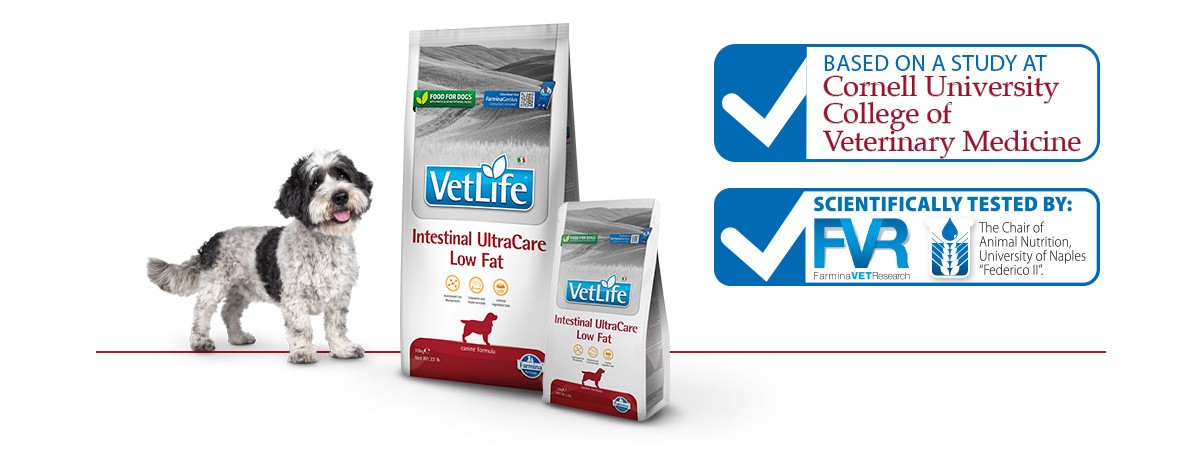Intestinal UltraCare low Fat
Up to 30% of veterinary visits in pets are related to vomiting or diarrhea.
VetLife Intestinal UltraCare Low Fat is the solution!
The latest addition to the Farmina VetLife product line, Intestinal UltraCare Low Fat is formulated to meet the specific requirements of dogs diagnosed with chronic enteropathy.
Its innovative formula, developed in collaboration with Cornell University, is backed by strong evidence-based medicine, highlighting Farmina’s commitment to excellence in pet nutrition.
Always consult your Veterinarian to ensure this product is appropriate for your pet.
What are canine chronic enteropathies?

Canine chronic enteropathy
Chronic enteropathies in dogs are diagnosed based on the presence of chronic or recurrent gastrointestinal clinical signs, including vomiting and diarrhea, occurring for more than three weeks.
The importance of diet
Recent studies refine Chronic Enteropathies (CE) classification in dogs, emphasizing the pivotal role of diet in their development and management, along with the interplay between gut health and microbiota.
For more information on canine chronic enteropathies
Read the study by Cornell University
Download the PDF file
VEtlife intestinal ultracare low fat
DESIGNED TO SUPPORT DOGS AFFECTED BY CHRONIC ENTEROPATHIES

- Lower fat content from fish oil, supports clinical recovery and remission in dogs with PLE.
- Vitamins and electrolyte integration, to increase and normalize serum concentrations of cobalamin and folate in dogs with CE
- Hydrolyzed fish protein as a sole protein source minimizes the risk of adverse reactions.
- Limited Ingredient Diet, Long-term clinical remission in dogs with CE.
VETLIFE INTESTINAL ULTRACARE LOW FAT

Farmina's solution to meet the needs of dogs with chronic enteropathy.
Recommended for
- Canine chronic enteropathy
- Reduction of intestinal absorptive disorders
- Compensation for maldigestion
- Exocrine pancreatic insufficiency (EPI)
Discover the product

Are you a Vet?
Find out more information on Canine Chronic Enteropathies and the studies supporting the formulation of VetLife Initestinal UltraCare Low Fat.
Find out more
more with farmina
.jpg)
- Up to 150€* savings
Access special offers and discounts by subscribing to a yearly plan.
- Genius Rewards
The program to rewards your loyalty. Enjoy a free bag after every 12 purchases.
Find out more
- Farmina Genius Support
Expert advice for you and your pets with a dedicated Farmina Consultant
*Total value calculated on a yearly plan of 12 bags of Vet Life Intestinal UltraCare 10kg which participated to Genius Reward getting 1 bag for free.
Find out the best nutrition for your pet
Connect with a Farmina Nutrition Consultant or download the Farmina Genius App to receive a personalized nutritional plan and consultancy, for free.
Find out more

